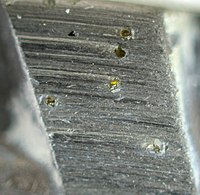
Photo from wikipedia
Aluminum alloys are soft and have low melting temperatures; therefore, machining them often results in cut material fusing to the cutting tool due to heat and friction, and thus lowering… Click to show full abstract
Aluminum alloys are soft and have low melting temperatures; therefore, machining them often results in cut material fusing to the cutting tool due to heat and friction, and thus lowering the hole quality. A good practice is to use coated cutting tools to overcome such issues and maintain good hole quality. Therefore, the current study investigates the effect of cutting parameters (spindle speed and feed rate) and three types of cutting-tool coating (TiN/TiAlN, TiAlN, and TiN) on the surface finish, form, and dimensional tolerances of holes drilled in Al6061-T651 alloy. The study employed statistical design of experiments and ANOVA (analysis of variance) to evaluate the contribution of each of the input parameters on the measured hole-quality outputs (surface-roughness metrics Ra and Rz, hole size, circularity, perpendicularity, and cylindricity). The highest surface roughness occurred when using TiN-coated tools. All holes in this study were oversized regardless of the tool coating or cutting parameters used. TiN tools, which have a lower coating hardness, gave lower hole circularity at the entry and higher cylindricity, while TiN/TiAlN and TiAlN seemed to be more effective in reducing hole particularity when drilling at higher spindle speeds. Finally, optical microscopes revealed that a built-up edge and adhesions were most likely to form on TiN-coated tools due to TiN’s chemical affinity and low oxidation temperature compared to the TiN/TiAlN and TiAlN coatings.
Journal Title: Materials
Year Published: 2021
Link to full text (if available)
Share on Social Media: Sign Up to like & get
recommendations!